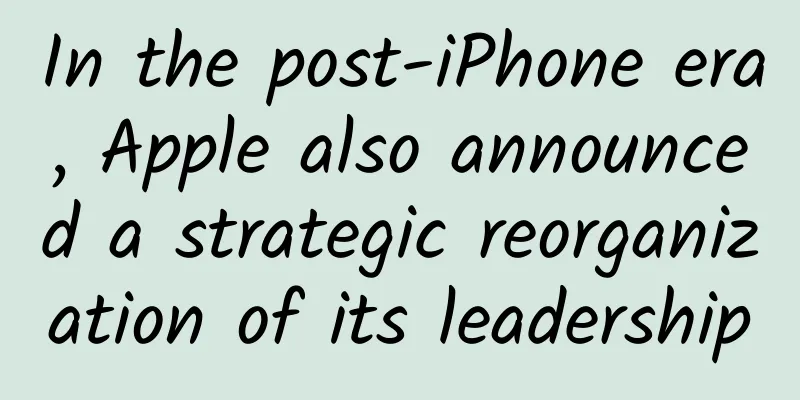In the post-iPhone era, Apple also announced a strategic reorganization of its leadership

|
Well-known Chinese and foreign technology companies ushered in a new keyword in 2019: restructuring. Following the adjustment of organizational structures by giants such as Tencent, Alibaba, Lenovo, and Xiaomi, the Wall Street Journal quoted multiple people familiar with the matter as saying that Apple is also reorganizing its management and readjusting priorities in services, artificial intelligence, hardware and retail departments in an effort to reduce its reliance on iPhone sales and shift the company's growth engine to services and potentially transformative technologies.
People familiar with the matter said that this change began last year, including high-level external hiring, internal executive departures, significant promotions and corresponding reorganizations, which even made Apple's ordinary employees unaccustomed to frequent leadership changes. These new changes have caused Apple to shelve several projects, and the newly appointed management has the opportunity to reassess priorities: "Former Apple employees said CEO Cook had foreseen as early as 2010 that the smartphone industry would mature and peak, and planned how to regain growth as phone sales slowed." For example, last April, Apple poached John Giannandrea, the former head of Google's artificial intelligence department, and promoted him to senior vice president of machine learning and artificial intelligence strategy in December last year, joining Apple's decision-making body - the 11-member executive team. It is reported that he will use artificial intelligence to personalize the service functions on Apple hardware devices. He also dismissed Bill Stasior, the executive who had been in charge of Apple's voice assistant Siri for the past seven years, in February this year and quickly took over Apple's flagship AI product, hoping to improve Siri's performance and accuracy. Last August, Apple rehired Doug Field, a former vehicle engineer who had worked at Tesla for five years. Doug Field was Apple's former vice president of engineering for Mac hardware, and together with his former colleague, Apple senior vice president Bob Mansfield, he was in charge of the autonomous driving project "Project Titan". In late January this year, financial media CNB disclosed that the Titan Project would lay off more than 200 people, accounting for 1/7 of the total number of project personnel. In early February this year, Apple unexpectedly announced that Angela Ahrendts, a "five-year veteran" and head of retail business, would leave in April. She was once regarded as Cook's successor and was also the former CEO of luxury fashion brand Burberry. Her salary even exceeded Cook's last year. But in the fourth quarter of last year, Apple's revenue "surprisingly" slowed down for the first time in a decade during the year-end shopping season. The company's head of human resources, Deirdre O'Brien, will take over the retail business, complete the renovation of more than 500 stores around the world, and determine how to promote Apple's service business in stores. It is reported that Apple is considering installing TVs in stores to promote new programs produced in cooperation with Hollywood. Last week, Apple once again demonstrated its determination to bet on augmented reality (AR) technology by transferring Frank Casanova, a senior executive previously responsible for iPhone marketing, to be responsible for AR marketing. This is the first time in the company's history that a senior AR marketing executive has been appointed. Analysts said that Casanova is an important figure in the launch of the iPhone, and this personnel change highlights Apple's ambitions in the AR field. Currently, iPhone sales still account for nearly two-thirds of Apple's total revenue. Although the company encourages investors to focus on its growing service business and stops disclosing the specific sales of key hardware such as mobile phones, computers, and tablets in its financial reports, Apple's new growth engine has not really started. The Wall Street Journal article pointed out that Apple invested $14.24 billion in research and development last year, a year-on-year increase of 23% from 2017. Although Apple continues to work on innovative projects in the fields of augmented reality, autonomous driving and health, it has not yet released new products in these areas that are comparable to the iPhone. Sales of Apple Watch, wireless headphones AirPods and smart speakers HomePod are also mixed. Wearable devices have the fastest revenue growth as "other products", but they cannot catch up with the pricing power or output of the iPhone. At the same time, Apple faces fierce competition in its services and innovation businesses. Netflix and Spotify's streaming services have more subscribers, Google's self-driving project Waymo is being commercialized and accumulating more mileage, and Amazon's Echo smart speaker has pushed Alexa's voice assistant into millions of homes. Apple CEO Cook said at an earnings conference in January 2017 that the revenue of the service business will double to $48 billion by the end of 2020, and the increase in the proportion of the service business will help boost gross profit margins. At the earnings conference at the end of January this year, Apple set a new goal to exceed 500 million paid subscribers on its platform by 2020, higher than the current 360 million. Some analysts pointed out that Apple hopes to maintain the loyalty of existing iPhone users and encourage iPhone users to buy more future Apple hardware through mobile payments, music services and the upcoming video/news subscription package. Wall Street Journal mentioned that Apple plans to hold a press conference on March 25 to launch a paid news subscription service based on Apple News, but will not release hardware products. This service is called "Netflix in the news industry". Users pay a monthly fee to read unlimited articles from news publisher partners. At the beginning of the year, there was also news that Apple plans to release iPhones and iPads equipped with 3D AR cameras in 2020, so that augmented reality technology can be "connected" with hardware. In addition, Apple plans to spend at least $1 billion this year to produce original video programs and invite Hollywood A-list actors and studios to join . According to people familiar with the matter, Apple is considering bundling video streaming and iCloud cloud storage into a monthly subscription service package, or combining it with a news subscription service for monthly sales. Eddy Cue, the company's service business director, poached two executives from Sony last year and put most of the engineering resources on video products. Most of the 200 employees laid off from the autonomous driving project were also transferred to the service business. Morgan Stanley has always been optimistic about the prospects of Apple's service business. Two weeks ago, it published a research report predicting that a series of new services launched in 2019, including video streaming, music subscriptions, App Store sales and mobile payments, will become an important driving force for Apple's stock price, and the stock price will rise by another 30% this year. JPMorgan Chase also believes that Apple, which has $250 billion in cash, may acquire Netflix to enhance Apple's position as a video content creator and participate in competition more efficiently. Investment bank Jefferies predicts that the fast-growing service sector will account for 40% of Apple's gross profit by fiscal 2020. Toni Sacconaghi, a technology researcher at Bernstein who claims to be "one of the most accurate Apple analysts," believes that with the growth of Apple's "search advertising" and other businesses, service business revenue may double to $49 billion in 2020. According to an optimistic analysis by Morgan Stanley cited by The Wall Street Journal, service business revenue will reach $50 billion in fiscal 2020, accounting for 60% of Apple's total revenue growth in the next five years, while its flagship product iPhone has provided 85% of revenue growth in the past five years. |
>>: Tik Tok launches its first mini-program game, let’s dance to the magical song!
Recommend
WeChat for Windows upgraded to version 3.3.0: You can browse Moments and search for updates
After 7 years of waiting, WeChat for Windows can ...
Wanted to prove Einstein's theory was wrong, but won the Nobel Prize for it
It is said that the Nobel Prize Committee of the ...
2G network will be eliminated by history. How long can the first generation iPhone survive?
At present, 4G LTE networks have been developing ...
The current situation and trends of Internet advertising!
Since the second half of 2018, the saying that di...
Get the latest course on new energy vehicles 2021 Baidu cloud download
Frontier Course: New Energy Vehicles 2021 Hello, ...
5 Laws of Strategy | Use the first one and you can ignore the other four
Before formulating a communication strategy, mark...
More than just full screen, what innovations will domestic mobile phone manufacturers have in 2016?
The lively 2016 has passed. It seems that the inte...
A review of extreme weather in 2023! How will the weather evolve in 2024?
As 2023 is coming to an end, I will first review ...
Closed "Chang'an" VS open "Bianjing", are the capital layouts of the Tang Dynasty and the Northern Song Dynasty "diametrically opposed"?
In the slave society and the early feudal society...
What are the three enemies that red fire ants fear the most? Why doesn’t the country eliminate red fire ants? Attached are the detailed reasons!
The red fire ant is a type of ant. It has strong r...
Three observations, one method: Don’t fight a marketing war without strategy
On January 15, the first lecture of the new year ...
Douyu product operation analysis
When it comes to games, I believe everyone’s firs...
Analysis of Douyin short video competitors!
Analysis of Douyin short video competitors 1. Bac...
Tavistock short-term dynamic therapy twelve-lecture online course complete set of materials
Tavistock Short-Term Dynamic Therapy 12-Lecture O...
XRDC: 2019 AR/VR Innovation Report
XRDC released the "2019 AR/VR Innovation Rep...









